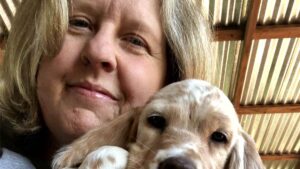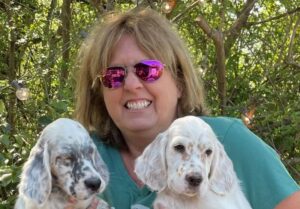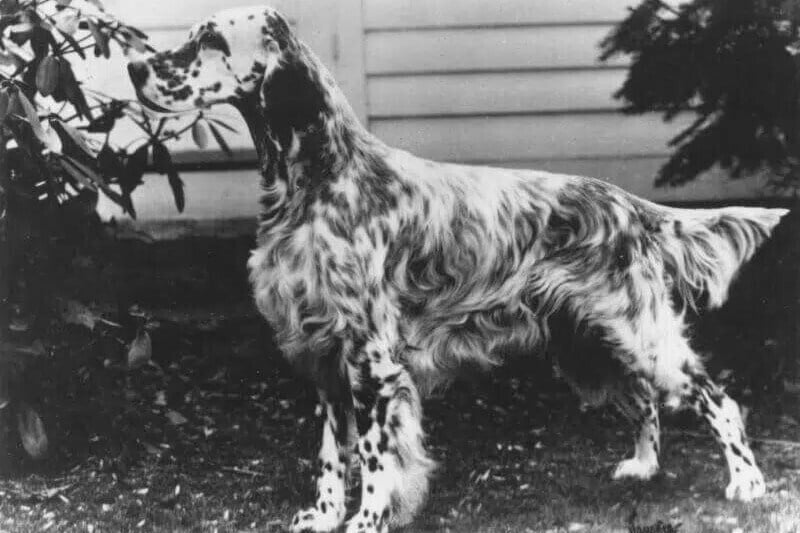
English: The Moderate Setter
Discover the elegant and symmetrical English Setter: a versatile gun dog known for its moderate temperament and hunting prowess.
Home » Dog Breeds » English Setter Dog Breed






The English Setter is a graceful and elegant breed, epitomizing both canine beauty and utility as a gun dog. It is one of the oldest gundog breeds, with roots that can be traced back to the 14th century in England. Characterized by a uniquely speckled coat and a gentle demeanor, the English Setter is as comfortable in the field as it is in the family home, making this gentle breed a versatile and cherished companion for outdoorsmen and homebodies alike.
Sporting
23 – 27 Inches
45 – 80 Pounds
12 Years
| Country of Origin | England |
|---|---|
| Bred For | Finding, Setting & Retrieving Birds, Companionship |
| Known For | Elegance, Charm, Friendliness |
| Popularity | Moderate |
| Temperament | Gentle, Affectionate, Friendly |
| Activities | Hunting, Running, Hiking, Conformation Shows, Dog Sports |
The English Setter has a rich heritage that traces back over several centuries, weaving a tale of hunting prowess, unwavering companionship, and refinement.
Originating in England, the breed’s development is credited to a mix of spaniel and pointer bloodlines, which were meticulously bred to produce the ideal bird dog. By the 19th century, dedicated breeders, including Sir Edward Laverack and R. Purcell Llewellin, made significant contributions to refining the breed, leading to the English Setter’s elegant appearance and its proficiency as a field dog.
The breed’s name gives a nod to its original function and behavior while working in the field. When the dog detects a game bird, it “sets” or crouches low, indicating the bird’s position to the hunter. This behavior distinguished these dogs from other bird dogs and gave rise to the setter’s distinctive name.
While the primary purpose of the English Setter was to assist with hunting birds, the breed’s gentle demeanor, striking good looks, and loyal nature quickly endeared it to households as a beloved companion. The reputation of the dogs transcended beyond hunting circles, leading them to become one of the first breeds recognized by purebred dog registries and dog show organizations.
The English Setter earned official recognition by the mid-19th century. The breed holds a special distinction in the United States as one of nine original “charter breeds” recognized by the American Kennel Club (AKC) in 1878. This early acknowledgment cemented the breed’s place among America’s sporting fraternity. Internationally, the Fédération Cynologique Internationale (FCI) has also recognized the breed, and in its homeland, The Royal Kennel Club in the UK has consistently celebrated and supported the enduring legacy of the breed.
Today, the breed’s journey from the English countryside to homes around the world highlights the versatility, charm, and lasting appeal of these stylish gun dogs. Valued both as an efficient hunter, an elegant show dog, and a loyal family member, the English Setter continues to hold a distinguished place in the pantheon of purebred dogs.
In terms of height, adult male English Setters typically stand between 25 to 27 inches tall at the shoulder, while mature females usually range from 23 to 25 inches in height.
When it comes to weight, males weigh approximately 65 to 80 pounds, and females tend to weigh between 45 to 55 pounds.
The English Setter has a medium to large frame that presents a harmonious balance of strength and elegance. The body is slightly longer than the dog is tall, ensuring agility and endurance in the field. This build suggests the capacity for great strength and stamina, with style and grace. The combination of strength of construction and high style is reflective of the breed’s origins as a hunting companion that is able to work tirelessly across varying terrain – and look good while doing so.
Texture: The English Setter boasts a medium-length coat that lies flat against the body. A slight wave is permissible, but the coat should never be wooly or curly. Instead, it must be silky to the touch, with feathering on the ears, chest, abdomen, underside of the thighs, backs of all legs, and on the tail. The feathering shouldn’t be so excessive as to hide the dog’s silhouette or its movement.
| Standard Color | |
|---|---|
| Blue Belton | ee |
| Blue Belton & Tan (Tri-Color) | ee |
| Lemon Belton | ee |
| Liver Belton | ee |
| Orange Belton | ee |
| White | ee |
Markings: The English Setter’s coat presents “belton” markings ranging from distinct flecking to roan shading. There are no specifically required markings for the breed.
A Note About Color: The coat’s color is white with darker hairs intermingled throughout known as “belton” markings. Consistent flecking of the darker-colored hairs is preferred, and heavy patches of color are undesirable. Tricolor dogs have solid tan on the muzzle, above the eyes, and on the legs.
The tail of the English Setter is an extension of the spine, lending balance to the dog’s overall appearance. It serves as an indicator of mood and intention, especially when the dog is at work in the field.
Positioned nearly level with the croup, the tail extends to a length reaching the hocks. It is carried straight or slightly curved, but it should never be raised too high. The feathering on the tail is long, forming a fringe that diminishes in length towards the tip.
The breed’s tail is never docked, allowing it to wave easily when the dog is in motion. The tail showcases the breed’s grace and fluidity, whether at a trot in the show ring or in pursuit of game in an open field.
Owning an English Setter requires making a commitment to a companion that is both gentle and active. As a dog deeply rooted in hunting traditions, the breed requires consistent engagement, both mentally and physically. Whether a hunting companion, show dog, or family pet, there are several things to consider to ensure this dog lives a fulfilling and happy life.
The English Setter is generally a healthy breed, but like all dogs, it can be subject to certain health anomalies. Recognizing early signs and providing preventive care play a crucial role in ensuring the longevity and well-being of the dog.
Lifespan: The English Setter typically has a lifespan of 12 years. Regular check-ups with a veterinarian and feeding a balanced diet can promote a healthier, and potentially longer, life.
The English Setter, like all breeds and mixed breeds, can be prone to certain health issues. Prospective owners should be aware of the following conditions that have been identified in some members of the breed. These include:
In addition to being aware of these potential risks, it is crucial to establish a regular veterinary check-up routine to detect and address any health issues early. Routine exams, especially as the dog ages, can help with early detection and management of common health problems, allowing the English Setter to lead a healthy and happy life.
The English Setter is often described as a “gentleman by nature,” with its temperament being one of its most endearing qualities. Gentle, calm, and friendly, English Setters are known for their affectionate nature, making them excellent companions for families.
For novice dog owners, the English Setter is a welcoming choice. The breed’s even-tempered and gentle nature often fits well with those who may be new to dog ownership. These dogs have a moderate sensitivity level, responding best to positive reinforcement. Harsh training methods are not suitable for these gentle souls; instead, a kind word and a gentle touch yield the best results.
While sociable and affectionate, English Setters prefer to be in the company of their human family or other pets rather than being left alone for extended periods. Isolation can sometimes lead to unwanted behaviors or signs of anxiety.
When it comes to interactions with other dogs, English Setters typically exhibit a friendly demeanor. Aggressive behavior is uncommon, and many setters relish playtime with their canine counterparts. This same gentle nature extends to children, making these dogs patient and loving family pets. As always, it’s important to ensure that interactions between dogs and young children are supervised to guarantee safety for both parties.
Lastly, strangers will often find a warm reception from an English Setter. They may initially bark to signal an approaching person, but after a brief introduction, they tend to be amicable and sociable. The overarching personality of the English Setter is one of mildness, kindness, and a genuine love for companionship.
Feeding an English Setter requires understanding the dog’s specific nutritional needs at each stage of life. Puppies have different dietary needs compared to adult dogs, and those needs change as they mature.
When feeding an English Setter puppy, it’s essential to provide the pup with high-quality puppy food that’s rich in essential nutrients to support rapid growth. Puppy food formulas typically have the right balance of proteins, fats, vitamins, and minerals that a growing puppy needs. For the first few months, puppies will generally require multiple smaller meals throughout the day to sustain their energy levels.
As English Setters transition to adulthood, their dietary needs change. An adult English Setter typically requires a well-balanced diet that includes protein, carbohydrates, fats, vitamins, and minerals. The exact amount of food a mature English Setter needs can vary based on the dog’s age, activity level, metabolism, and overall health. On average, many adult English Setters do well on about 2 to 2.5 cups of high-quality dog food divided into two meals a day.
However, always be guided by the recommendations provided by the dog food manufacturer and, more importantly, consult with a veterinarian or canine nutritionist to determine the ideal amount and type of food for the individual dog.
Feeding charts can be a helpful tool to gauge the amount of food required, but it’s essential to monitor the dog’s weight and make adjustments as necessary. Overfeeding or underfeeding can lead to health issues, so being vigilant about portion sizes and feeding routines is crucial.
It’s also worth noting that English Setters can sometimes be prone to obesity, especially if they aren’t getting enough exercise. Treats should be given in moderation and factored into the dog’s daily caloric intake to be sure the dog is maintaining a healthy weight.
The English Setter is known for its amiable disposition, but like all breeds, it benefits from consistent training to become well-mannered and responsive. Training an English Setter can be a rewarding experience due to the breed’s willingness to please and its affectionate nature.
The breed’s intelligence is evident in the English Setter’s ability to grasp new commands, but these dogs also have an independent streak, which might sometimes be mistaken for stubbornness. Positive reinforcement methods, such as treats, praise, and play, tend to yield the best results. Harsh corrections or training techniques can be counterproductive, as they might cause the dog to become hesitant or even fearful.
Barking is a trait that some English Setters might exhibit, especially if they are alerting their owners to something unusual in their environment. While it’s natural for these dogs to bark occasionally, it’s beneficial to train them to stop on command or to reduce excessive barking.
Another aspect to consider is the breed’s inherent bird-hunting instincts. The English Setter has a natural “birdiness” and might be inclined to chase after birds or even other small animals. Training these setters to have a reliable recall, and working on impulse control, can be particularly important, especially in open areas.
The potential for wanderlust is another factor to consider. While these dogs are typically devoted to their families, the allure of chasing a scent or exploring a new area can be tempting. It’s crucial to ensure they’re in a secure area or on a leash during walks to prevent them from wandering off.
Predatory instincts are generally low in English Setters compared to some other breeds, but it’s always wise to monitor interactions with small pets and unfamiliar animals.
English Setters, with their sporting dog lineage, naturally possess a high degree of energy and stamina. Catering to their exercise needs is essential for their physical and mental well-being. The breed’s energy level often surprises many, given the dog’s gentle and laid-back demeanor indoors.
| Energy Level | Medium |
|---|---|
| Exercise Requirements | 90 Minutes/Day, Daily Walks, Vigorous Running, Regular Exercise, Playing with Another Dog, Mental Stimulation |
These dogs thrive when they receive regular and ample opportunities to stretch their legs and run. This exercise not only taps into their athletic prowess, it also helps to manage their weight and overall health. A long, brisk walk, or even better, a run in a secured open area can be beneficial for them.
The intensity of their play and exercise sessions can vary depending on individual dogs and their age. Younger English Setters are notably more energetic and require more vigorous activities, while older ones might prefer moderate exercise.
Playfulness is another hallmark of the breed. Engaging this breed in interactive games, like fetch or tug-of-war, can be both fun and rewarding. It not only provides physical stimulation but also reinforces the bond between the dog and the family members.
However, it’s essential to remember that while physical exercise is crucial, mental stimulation is equally important for the English Setter. Activities that challenge the dog’s mind, like puzzle toys or obedience training sessions, can be very satisfying for this strong and gentle breed.
The English Setter, known for its beautiful, flowing coat, requires regular grooming to keep it looking its best and to maintain its health. This breed’s coat is not only aesthetically appealing but also functional, having originally been meant to protect the dog from brambles and underbrush during hunting sessions.
| Coat Type | Flat with Feathering |
|---|---|
| Grooming Requirements | Daily Combing, Weekly Brushing, Occasional Bathing, Routine Ear Cleaning, Periodic Nail Trimming, Regular Tooth Brushing |
Grooming an English Setter is relatively straightforward, but consistent care is key. The breed’s coat can range from flat to slightly wavy and is of medium length. Regular combing and brushing, at least a few times a week, will help to prevent tangles and matting while also distributing the natural oils of the skin. This routine not only ensures that the coat remains silky and lustrous, it also offers a chance to check for any skin issues, ticks, or other potential problems.
While English Setters are not considered heavy shedders compared to some breeds, they do shed year-round, with some increased shedding typically seen in the spring and fall. Regular brushing aids in managing and reducing the amount of loose hair around the house.
Beyond brushing, regular ear cleaning is essential for the English Setter. The breed’s floppy ears can be prone to infections if not kept clean and dry. Checking the ears weekly and cleaning as needed can help to prevent potential issues from becoming chronic problems.
Additionally, like all breeds, the English Setter benefits from regular nail trims to prevent overgrowth, which can lead to discomfort or even injury. Dental care, including brushing the teeth or providing dental chews, helps to maintain good oral health and fresh breath.
Life with an English Setter can be a delightful experience, but understanding the breed’s unique needs and preferences will ensure both the dog and its human companion enjoy a harmonious life together.
For those residing in apartments, it’s worth noting that while English Setters can adapt to apartment living, they do require ample daily exercise to expend their inherent energy. A lack of activity can result in restlessness or unwanted behaviors. However, with sufficient exercise and mental stimulation, they can be quite content in smaller spaces.
Given the breed’s origin as a bird dog in the somewhat chilly British Isles, English Setters generally fare well in cooler weather. Their medium-length coat offers protection against the cold, but it’s essential to monitor them during extreme conditions to ensure they’re not exposed for extended periods. Regular grooming also helps to maintain the insulating properties of their coat.
On the other hand, in hot weather, care should be taken. Like many dogs, English Setters can be susceptible to heat exhaustion or heat stroke. It’s crucial to provide them with plenty of shade and fresh water, and to avoid intense physical activities during the peak heat hours of the day.
In essence, living with an English Setter means understanding the breed’s sporting dog lineage while also catering to the affectionate and sociable nature of these dogs. Providing them with a balanced mix of exercise, mental stimulation, and loving companionship all but guarantees that life with this breed will be both rewarding and fun-filled.
The arrival of English Setter puppies brings a bundle of joy and energy into the household. These puppies, with their soft coats and expressive eyes, quickly endear themselves to their families. However, it’s crucial to remember that this phase of their life is foundational. The experiences, training, and care they receive during this period will greatly influence their temperament and behavior as adults.
Raising an English Setter puppy requires a combination of proper nutrition, early socialization, consistent training, and regular health check-ups.
Nutrition plays a pivotal role in the healthy development of the puppy. A diet rich in essential nutrients supports the pup’s rapid growth and ensures it matures into a strong and healthy adult. It’s advisable to consult with a veterinarian to determine the best food and feeding schedule tailored to the specific needs of the puppy.
Socialization is another key aspect of raising a well-adjusted English Setter. Introducing the puppy to a variety of experiences, environments, people, and other animals during their early months helps them grow into confident and sociable adults. Positive experiences during this critical period can prevent the development of unnecessary fears or aggressive behaviors later in life.
Consistent training from a young age is vital. English Setter puppies, like all young dogs, can be playful and a bit mischievous. Establishing boundaries, teaching basic commands, and reinforcing positive behaviors will set the stage for a well-behaved adult dog. Using reward-based training methods is often the most effective approach with this breed.
Lastly, regular vet check-ups and vaccinations are essential to monitor the puppy’s health and protect them from various infectious diseases. Following a recommended vaccination and deworming schedule will ensure the puppy stays healthy and gets a great start in life.
Originating as bird dogs, English Setters possess a natural athleticism and a keen sense for various activities and dog sports. Engaging them in these activities not only taps into their inherent skills, it also provides an excellent outlet for their energy and an opportunity for bonding with their owners.
The breed’s combination of athleticism, intelligence, and temperament makes the English Setter well-suited for a variety of activities and dog sports. Whether these dogs are competing at a high level or simply enjoying these activities recreationally with their owners, they are likely to thrive when their natural talents are recognized and nurtured.
The English Setter is recognized by the world’s leading registries and kennel organizations, which categorize the breed into a specific Group based on its unique characteristics. This breed is recognized worldwide under the following Group designations:
| Organization | Group Designation |
|---|---|
| AKC (American Kennel Club) | Sporting |
| UKC (United Kennel Club) | Gun Dog |
| CKC (Canadian Kennel Club) | Sporting Dogs |
| ANKC (Australian National Kennel Council) | Gundogs |
| RKC (The Royal Kennel Club) | Gundog |
| FCI (Fédération Cynologique Internationale) | Group 7 – Pointing Dogs; Section 2.2 – British and Irish Pointers and Setters |
The ideal English Setter is described by a Breed Standard that is approved by each of the world’s leading registries and kennel organizations. The Breed Standards for this breed may be found in the following links:
| Organization | Breed Standard |
|---|---|
| American Kennel Club | AKC English Setter Breed Standard |
| United Kennel Club | UKC English Setter Breed Standard |
| Canadian Kennel Club | CKC English Setter Breed Standard |
| Australian National Kennel Council | ANKC English Setter Breed Standard |
| The Royal Kennel Club | RKC English Setter Breed Standard |
| Fédération Cynologique Internationale | FCI English Setter Breed Standard |
Being a breed of such renown, the English Setter enjoys support and celebration from breed-specific clubs around the world. These clubs, dedicated to the preservation, education, and welfare of the English Setter, play a crucial role in bringing together enthusiasts, breeders, and potential owners.
In the United States, the English Setter Association of America (ESAA) stands as a prominent organization dedicated to promoting the breed’s well-being through social and competitive events, and by offering resources to breed aficionados. The ESAA is deeply committed to the health, training, and public awareness of the English Setter.
Canada has its dedicated enthusiasts as well, with organizations such as the English Setter Club of Canada (ESCC) taking the lead in championing the breed. The ESCC fosters a sense of community among English Setter lovers in the provinces, organizing events and providing resources that resonate with the breed’s rich heritage.
In the United Kingdom, the English Setter Association stands as a testament to the breed’s long-standing history and its roots in British culture. Founded in 1951, it is a hub for all things English Setter, from organizing breed-specific events to fostering an informed and passionate community of admirers.
Involvement with these breed clubs provides a wealth of information, camaraderie, and support for anyone keen on immersing themselves in the world of the English Setter.
The charm and elegance of the English Setter have won the hearts of many. Yet, like many dogs, they may occasionally find themselves in need of rescue or rehoming. Rescue groups dedicated to the breed step in during these moments, offering a lifeline to English Setters in need.
In the United States, organizations like Above and Beyond English Setter Rescue have been at the forefront since 2004, tirelessly saving and rescuing dogs that require assistance. The group’s dedication ensures that these dogs, which might have once faced uncertainty, are provided with another chance at a happy, loving life.
In Canada, the English Setter Club of Canada Rescue plays a pivotal role in protecting dogs that come under distress. The organization’s volunteers provide necessary care, support, and temporary homes for English Setters in need, with the aim of placing them in environments where they can thrive.
In the United Kingdom, the English Setter Rescue UK focuses on rehoming and providing care to English Setters in need. Additionally, the English Setter Association itself operates a dedicated rescue group, demonstrating its profound commitment to the well-being and future of the breed in its native land.
The English Setter is a member of the Sporting Group, originally bred for hunting game birds. Characterized by its unique “belton” coat pattern, this breed is admired for its beauty as well as for its keen sense and ability to “set” when it locates hidden birds.
Yes, English Setters shed. Their silky, medium-length coat undergoes regular shedding and requires consistent grooming to keep it in top condition. Brushing and combing several times a week can help to minimize loose hairs and keep the coat healthy.
English Setters are medium to large dogs. Males typically stand between 25 and 27 inches tall at the shoulder, while females generally measure from 23 to 25 inches. Weight can vary, but most English Setters fall within the range of 45 to 80 pounds, depending on their gender and overall build.
English Setters are agile and swift, traits honed from their hunting ancestry. While not as fast as some sprinting breeds, these setters can reach speeds up to 35 miles per hour. Their speed, combined with stamina, make them excellent bird dogs in open fields.
English Setters typically have a lifespan of 12 years. With proper care, regular veterinary check-ups, and a healthy diet, some can live even longer. Like all dogs, their lifespan can be influenced by genetics, overall health, and environmental factors.
While English Setters are relatively adaptable, they thrive on companionship and activity. Leaving them alone for extended periods can lead to boredom and potentially destructive behaviors. If an owner must be away for long durations, it’s beneficial to provide enrichment activities or arrange for periodic check-ins throughout the day.
English Setters are considered moderate to high maintenance, primarily due to their grooming needs. Their feathered coat requires regular brushing to prevent matting and tangling. Additionally, as active and intelligent dogs, they need consistent exercise and mental stimulation to stay content.
English Setters can be vocal, especially if they’re bored, anxious, or trying to alert their owners to something in their immediate environment. While they don’t typically bark excessively without reason, it’s essential to address any underlying causes of excessive barking, such as a lack of exercise or mental stimulation.

Discover the elegant and symmetrical English Setter: a versatile gun dog known for its moderate temperament and hunting prowess.

Learn about judging the English Setter: discover key traits, balance, movement, and structure that make this breed exceptional in the field.

Lori Whorff is the breeder behind Camellia English Setters. Read about the kennel’s beginnings, puppies, and much more!

Joan Savage is the breeder behind Stagedoor English Setters. Read about the kennel’s beginnings, puppies, and more!

Melissa Newman is the breeder behind Setter Ridge Kennel English Setters. Read about the kennel’s beginnings, puppies, and much more!

Dr. Jill Warren is the breeder of Esthete English Setters. Read about the kennel’s beginnings, the dogs, the puppies, and much more.

Lori Whorff is the breeder behind Camellia English Setters. Read about the kennel’s beginnings, the sires, the dams, the puppies, and more!

English Setters at their best are beautiful dogs. Their elegance and structure serve them well in both the show ring and in the field.

Discover the elegant and symmetrical English Setter: a versatile gun dog known for its moderate temperament and hunting prowess.

Learn about judging the English Setter: discover key traits, balance, movement, and structure that make this breed exceptional in the field.

Lori Whorff is the breeder behind Camellia English Setters. Read about the kennel’s beginnings, puppies, and much more!

Joan Savage is the breeder behind Stagedoor English Setters. Read about the kennel’s beginnings, puppies, and more!

Melissa Newman is the breeder behind Setter Ridge Kennel English Setters. Read about the kennel’s beginnings, puppies, and much more!

Dr. Jill Warren is the breeder of Esthete English Setters. Read about the kennel’s beginnings, the dogs, the puppies, and much more.

Lori Whorff is the breeder behind Camellia English Setters. Read about the kennel’s beginnings, the sires, the dams, the puppies, and more!

English Setters at their best are beautiful dogs. Their elegance and structure serve them well in both the show ring and in the field.
The best way to ensure a long and happy relationship with a purebred dog is to purchase one from a responsible breeder. Not sure where to begin?
Contact the National Parent Club’s Breeder Referral Program, which is listed on the AKC Breeder Referral Contacts page.


"*" indicates required fields
Showsight Magazine–the world’s most influential purebred dog publication since 1992. Each issue reaches a global audience dedicated to preserving the history and health of purpose bred dogs. Filled with award-winning editorial focused on news and insights from the dog show community, top breeders, handlers, AKC Judges, and more!